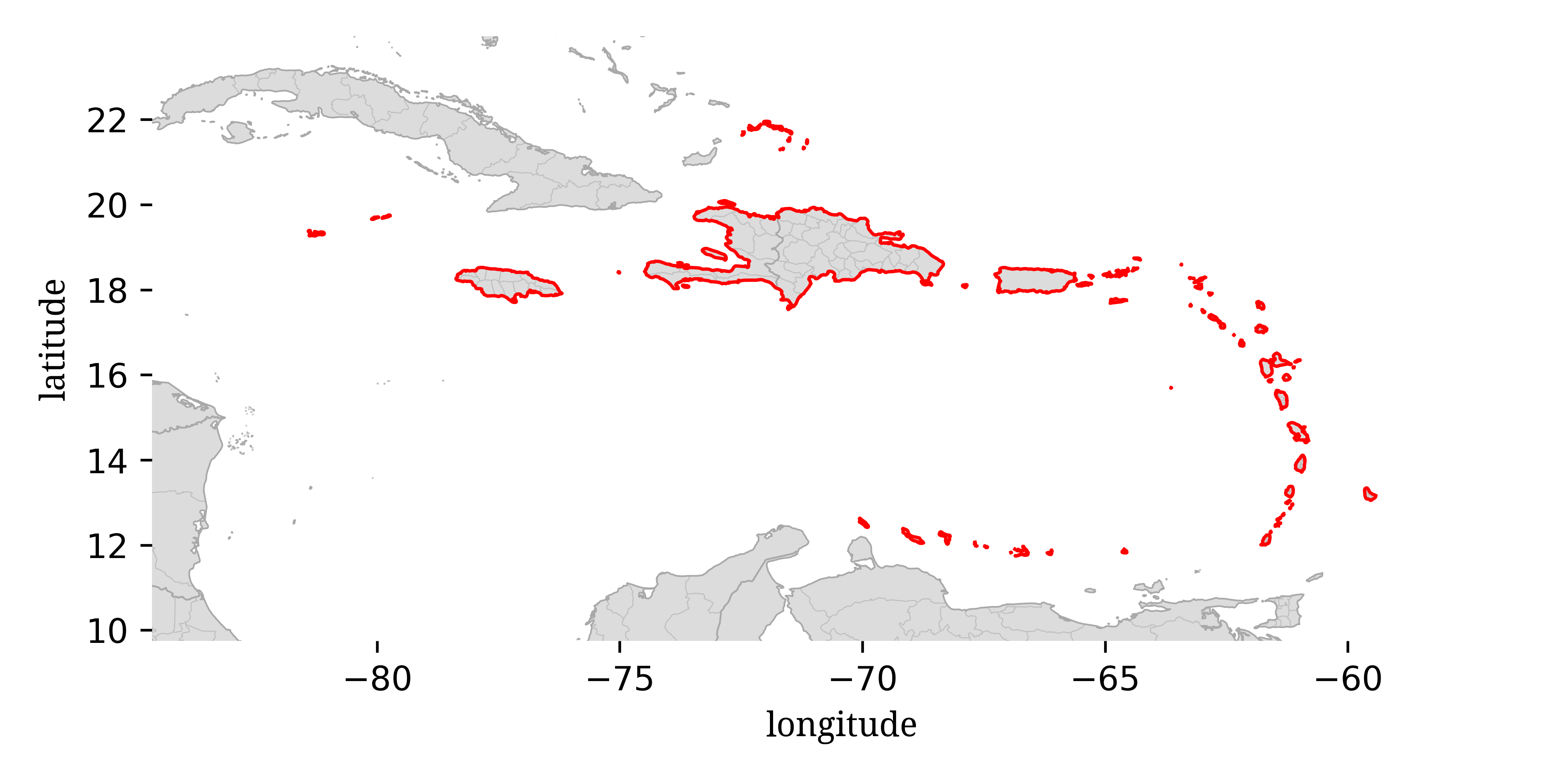
This guide is designed for identification “in the field” where you might be looking at live crabs by eye or through binoculars or from photographs. I will generally try to avoid characters that will require you to physically catch the crab, although I may mention a few for secondary verification. It does not include the more strict taxonomist-style characters that may only be visible under a microscope or via dissection. It is also assumed that the individuals are living, as death (and even capture) can cause dramatic color change.

This is a guide to the fiddler crabs of the islands of the Caribbean, excluding Cuba (which has its own guide) and Trinidad and Tobago (which are included with the guide for the Guianas).
A number of features can be used to distinguish among these species, but a good place to start is to look at the distance between the base of the eyestalks. Fiddler crabs tend to split into two groups, those with the eyestalks very close together (“narrow front”) and those with the eyestalks separated a bit more (“broad front”). One of these species, Uca major, is a narrow front species, while the others are broad front species.
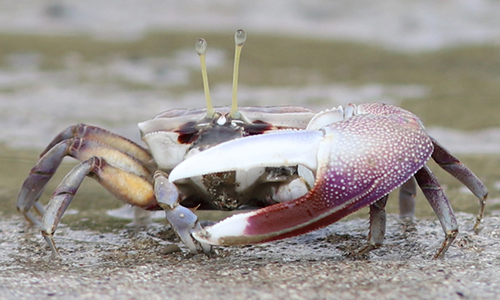

Uca major is readily recognizable in the region as it is one of only two narrow front species. Its carapace is generally white or dark brown/red, it has long yellow eyestalks, the upper finger on the claw is white, and the lower finger has a deep wine red patch on it. It is all but impossible to confuse with Uca maracoani (see below).
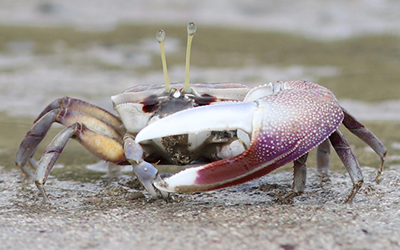
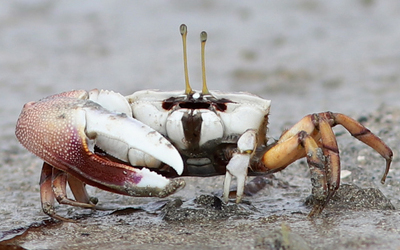

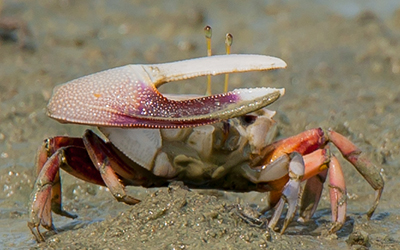
Leptuca thayeri can be distinguished from the other species by a variety of characteristics. The more subtle difference which may not always be readily visible is the distance between the eyestalks. Other than the two narrow front species Uca major and Uca maracoani, Leptuca thayeri has eyestalks that are much closer together than other broad front species. Compare the amount of carapace—as well as the shape of that part of the carapace—that is found between the eyestalks in the following photos.
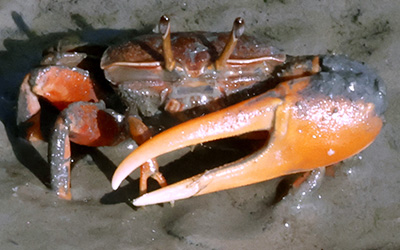
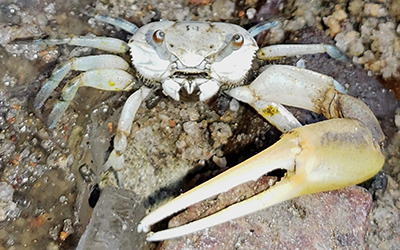
In general, species in the genus Minuca have eyes farther apart than those in the genus Leptuca, but even compared to Leptuca leptodactyla and Leptuca cumulanta, Leptuca thayeri has eyes that are particularly close together. In Leptuca thayeri the bit of carapace that comes between the eyestalks has parallel edges, making the extrusion relatively rectangular in shape. In the other three species, the edges of the carapace between the eyes slope together, making the extrusion appear more trapezoidal. In Uca major that narrow part of the front is pinched together.
Leptuca thayeri is generally a distinct color from the other species. Its body (both carapace and legs) tends to be relatively solid colored, either a dull brown or dark red. The large claw also tends to be almost entirely a solid color, usually dull orange or fading to a salmon pink, with the tips of the claw sometimes a paler white.
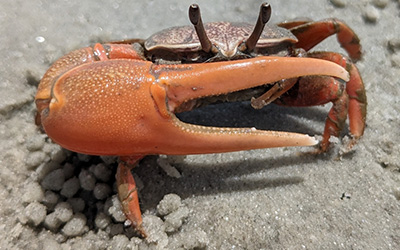
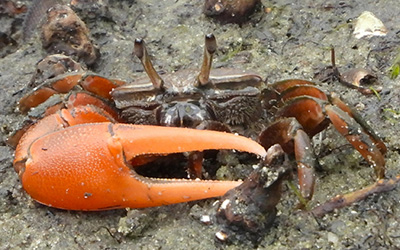
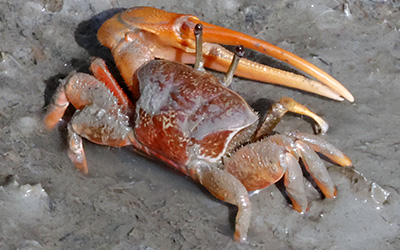
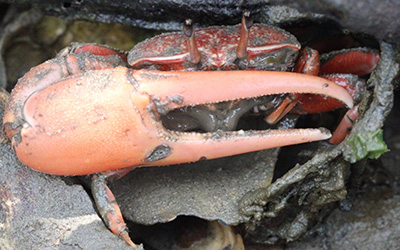
The final charactersistic to help distinguish Leptuca thayeri are some subtle differences in the shape of the large claw. Larger male Leptuca thayeri have fingers on the large claw that are relatively longer, compared to the size of the “hand”, than those of the other species. In addition, in the other species, the lower finger of the large claw (the pollex) is generally fairly straight, with a bit of upward curvature toward the end. In many male Leptuca thayeri (although not all), this finger will curve back downward toward the end. The extra-long fingers with the downward curve is quite distinct once you learn to recognize it, although smaller male Leptuca thayeri may not show this feature. Compare the shape of the lower finger of the large claw in the photos below to those of the other species (as well as the other Leptuca thayeri above).
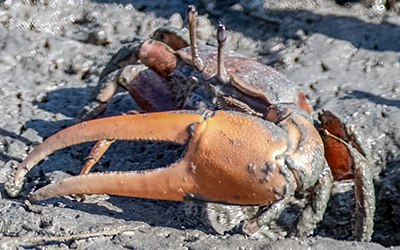
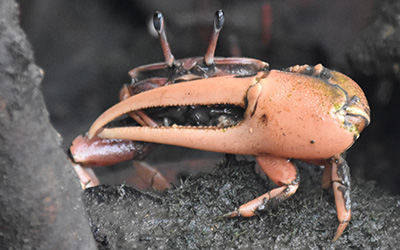
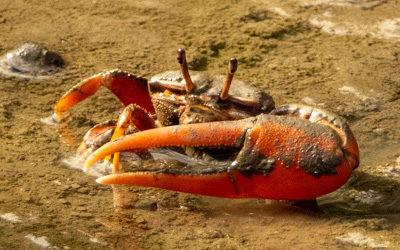
Leptuca leptodactyla prefers sandier beaches and is generally distinguishable by color and the particularly long, thin fingers on its large claw. It has a carapace that ranges from dark gray to almost pure white, occasionally somewhat yellow. The limbs and claw are generally a mix of yellow and white.

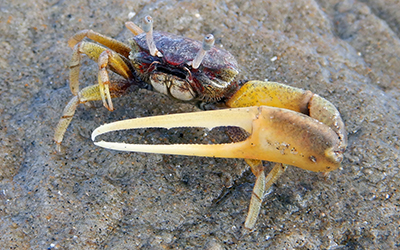

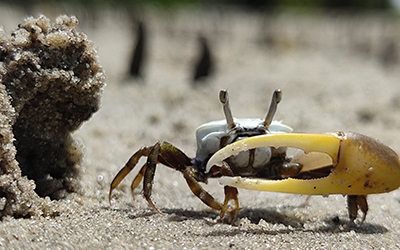
It will sometimes build structures next to its burrows (see fourth photo above), much like its Pacific coast relatives.
Leptuca cumulanta is a small species, about the same size as Leptuca leptodactyla, but smaller than all of the others in the area with a carapce about 1 cm in width. Its carapace is frequently a shining turquoise blue or green, often with marbled dark and light sections. The large claw is generally a yellow-brown with white-yellow fingers, occasionally with a touch of pink at the tips or base.
Leptuca cumulanta does not have overly long, thin fingers of Leptuca leptodactyla and a narrower front than the various Minuca, making it moderately easy to identify in the area.
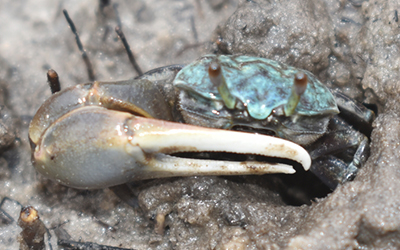

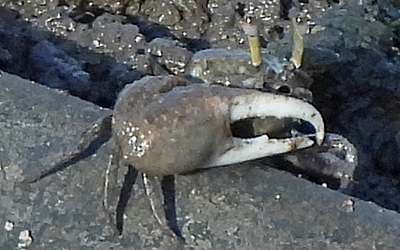
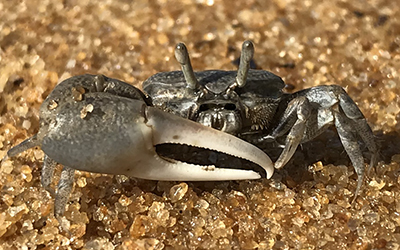
Generally, the Atlantic Minuca species can be very difficult to tell apart as they largely have similar shapes and structures and at best only differ by subtle color differences. Many of the Atlantic Minuca have predominantly two-toned carapaces, tending to have one color (or pattern) over the front half and a different, darker color over the back half. While the back half is frequently a dark brown, the color in the front half can sometimes be used to distinguish different species.
One very subtle difference between some of the species in this genus is the breadth of the front. While Minuca generally have the broadest fronts of any fiddler crabs, within the genus the species split into roughly two groups, those whose front is less than ⅓ of the width of the total carapace and those whose front is ⅓ or more of the width of the total carapace. Of the species in this region, Minuca rapax has a relatively narrower front, while Minuca burgersi and Minuca vocator have relatively broader fronts. Front width can be difficult to estimate with any accuracy (particularly in the field), as it is formally measured as the distance between the margins of the eyebrows, but there are individuals where the front is particularly broader or narrower. An additional complication is that within a species, the relative width of the front increases as crabs get larger (smaller individuals have relatively narrower fronts than larger individuals). Despite all of this, it is still a character that may sometimes be useful in distinguishing these species.
Color descriptions of Minuca vocator are sparse, but generally it is described as having a solid colored carapace (rather than the two toned ones found in the other Minuca), ranging from dull brown or gray to pale yellow or dull red or orange. The claw is generally described as a pale yellow or red, with white fingers. Minuca vocator has a particularly wide front, generally consisting of more than ⅓ of the total carapace breadth, with only Minuca burgersi similarly broad within this region. Other species in the region generally have a front breadth that is less than ⅓ of the total carapace breadth.
Minuca vocator has many small clumps of hairs scatterd around its carapace; these attract mud, giving it a patchy, muddy look that is different from other species. There are simliar hairs covering much of their walking legs, giving their legs a particularly muddy appearance as well.
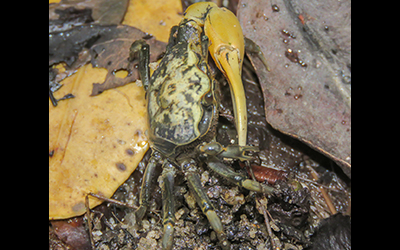
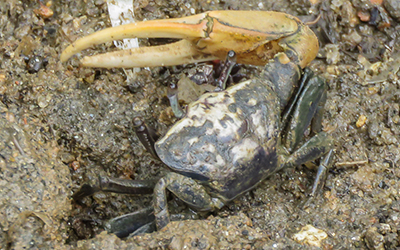
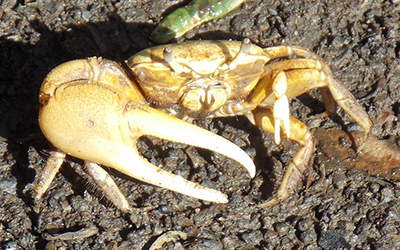
For Minuca burgersi, the front of the carrapace is generally gray, with some purple marbling, with the back half more solid chocolate-brown or purple-brown. The H-shaped depression in the carapace is frequently a purplish red-brown. The large claw is generally a medium orange with paler fingers. Like Minuca vocator, the front of Minuca burgersi is on the wider side, generally consisting of more than ⅓ of the total carapace breadth.
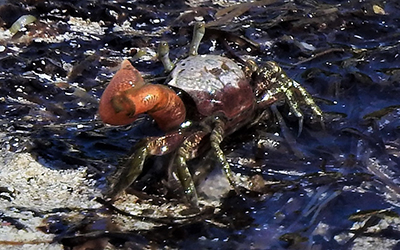
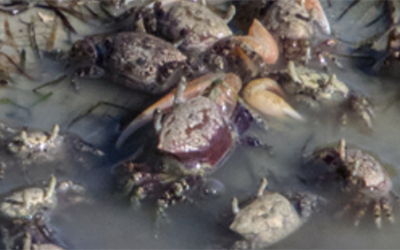
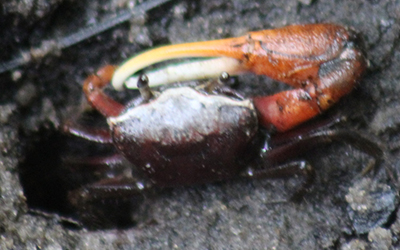
Minuca rapax appears to be one of the most common, and most variable, of the western Atlantic species. It is quite similar to Minuca burgersi, although trends toward more grays and less purple/reds. One of the challenges with a site like iNaturalist is that Minuca rapax seems to be the default "suggested species" for a large part of the western Atlantic, so a lot of the photographs identified as this species are likely other similar species from the same genus, which makes identifying the actual degree and range of color variation in this species difficult.
The two-toned coloration of the carapace of Minuca rapax appears to primarily be a lighter gray in the front half and a darker gray in the back half, but there may be quite a bit more variation beyond this. The claw is generally a medium to pale yellow-orange, with the lower finger trending toward white. There is frequently some purple speckling at the front of the carapace behind the eyes. It is less usual for the H-shaped depresion to be distinctly colored.